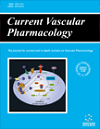- Home
- A-Z Publications
- Current Vascular Pharmacology
- Previous Issues
- Volume 20, Issue 3, 2022
Current Vascular Pharmacology - Volume 20, Issue 3, 2022
Volume 20, Issue 3, 2022
-
-
Current Insights on the Role of Irisin in Endothelial Dysfunction
More LessAuthors: Eder Luna-Ceron, Adrian M. González-Gil and Leticia Elizondo-MontemayorEndothelial dysfunction is a crucial physiopathological mechanism for cardiovascular diseases that results from the harmful impact of metabolic disorders. Irisin, a recently discovered adipomyokine, has been shown to exert beneficial metabolic effects by increasing energy consumption, improving insulin sensitivity, and reducing the proinflammatory milieu. Multiple preclinical models have assessed irisin's possible role in t Read More
-
-
-
Role of Glycine and Glycine Receptors in Vascular Endothelium: A New Perspective for the Management of the Post-Ischemic Injury
More LessGlycine Receptors (GlyRs) are cell-surface transmembrane proteins that belong to the Cysloop ligand-gated ion channels superfamily (Cys-loop LGICs). Functional glycine receptors are conformed only by α-subunits (homomeric channels) or by α- and β-subunits (heteromeric channels). The role of glycine as a cytoprotective is widely studied. New information about glycine modulation of vascular endothelial cells (ECs) functio Read More
-
-
-
Interleukin-10 in the Vasculature: Pathophysiological Implications
More LessAuthors: Raiany A. de Freitas, Victor V. Lima, Gisele F. Bomfim and Fernanda R.C. GiachiniInterleukin-10 (IL-10) is an important immunomodulatory cytokine, initially characterized as an anti-inflammatory agent released by immune cells during infectious and inflammatory processes. IL-10 exhibits biological functions that extend to the regulation of different intracellular signaling pathways directly associated with vascular function. This cytokine plays a vital role in vascular tone regulation by changing important pr Read More
-
-
-
The Role of Inflammation as a Preponderant Risk Factor in Cardiovascular Diseases
More LessCardiovascular diseases cause considerable health and economic burden, as they are the leading cause of disability and death in the western world. Inactivity, hypertension, obesity, diabetes, and smoking are among the classic risk factors for cardiovascular disease. From a pathophysiological point of view, the arteries of our body bear the harmful stimuli produced by these factors and respond to them with Read More
-
-
-
Intermittent Fasting as Possible Treatment for Heart Failure
More LessWestern-style diet often leads to food overconsumption, which triggers the development of comorbidities, such as obesity, insulin resistance, hypercholesterolemia, hypertriglyceridemia, type 2 diabetes, and heart failure (HF). Several studies suggest that intermittent fasting (IF) protects against the development of those morbidities. This study presents evidence of the beneficial effects of IF on HF. Based on the current evi Read More
-
-
-
Contribution of STIM-Activated TRPC-ORAI Channels in Pulmonary Hypertension Induced by Chronic Sustained and Intermittent Hypoxia
More LessAuthors: Sebastián Castillo-Galán, Germán A. Arenas and Rodrigo IturriagaSustained and intermittent hypoxia produce vasoconstriction, arterial remodeling, and hypertension in the lung. Stromal interaction molecule (STIM)-activated transient receptor potential channels (TRPC) and calcium release-activated calcium channel protein (ORAI) channels (STOC) play key roles in the progression of pulmonary hypertension in pre-clinical models of animals subjected to sustained and intermittent hypoxia Read More
-
-
-
Pharmacy and Exercise as Complimentary Partners for Successful Cardiovascular Ageing
More LessAuthors: Luke A. Howlett, Sandra A. Jones and Matthew K. LancasterDiseases of the cardiovascular system have been the biggest cause of mortality for the majority of the last century, currently contributing to almost a third of deaths every year globally. Ageing associates with changes to the structure and function of the heart and vascular system that progressively increase the incidence of abnormalities, morbidity, and cardiovascular disease. The burden of ageing and its relationship t Read More
-
-
-
Varicocele at High Altitude; Venous Outflow Restriction by Hypobaric Hypoxia
More LessBackground: Testicular aches have been reported to occur on exposure to high altitude (HA). As a painful expression of venous congestion at the pampiniform plexus, varicocele (VC) might be a consequence of cardiovascular adjustments at HA. Chile’s National Social Security Regulatory Body (SUSESO) emphasized evaluating this condition in the running follow-up study “Health effects of exposure to chronic intermittent hypoxi Read More
-
Volumes & issues
-
Volume 23 (2025)
-
Volume 22 (2024)
-
Volume 21 (2023)
-
Volume 20 (2022)
-
Volume 19 (2021)
-
Volume 18 (2020)
-
Volume 17 (2019)
-
Volume 16 (2018)
-
Volume 15 (2017)
-
Volume 14 (2016)
-
Volume 13 (2015)
-
Volume 12 (2014)
-
Volume 11 (2013)
-
Volume 10 (2012)
-
Volume 9 (2011)
-
Volume 8 (2010)
-
Volume 7 (2009)
-
Volume 6 (2008)
-
Volume 5 (2007)
-
Volume 4 (2006)
-
Volume 3 (2005)
-
Volume 2 (2004)
-
Volume 1 (2003)
Most Read This Month
Article
content/journals/cvp
Journal
10
5
false
en


